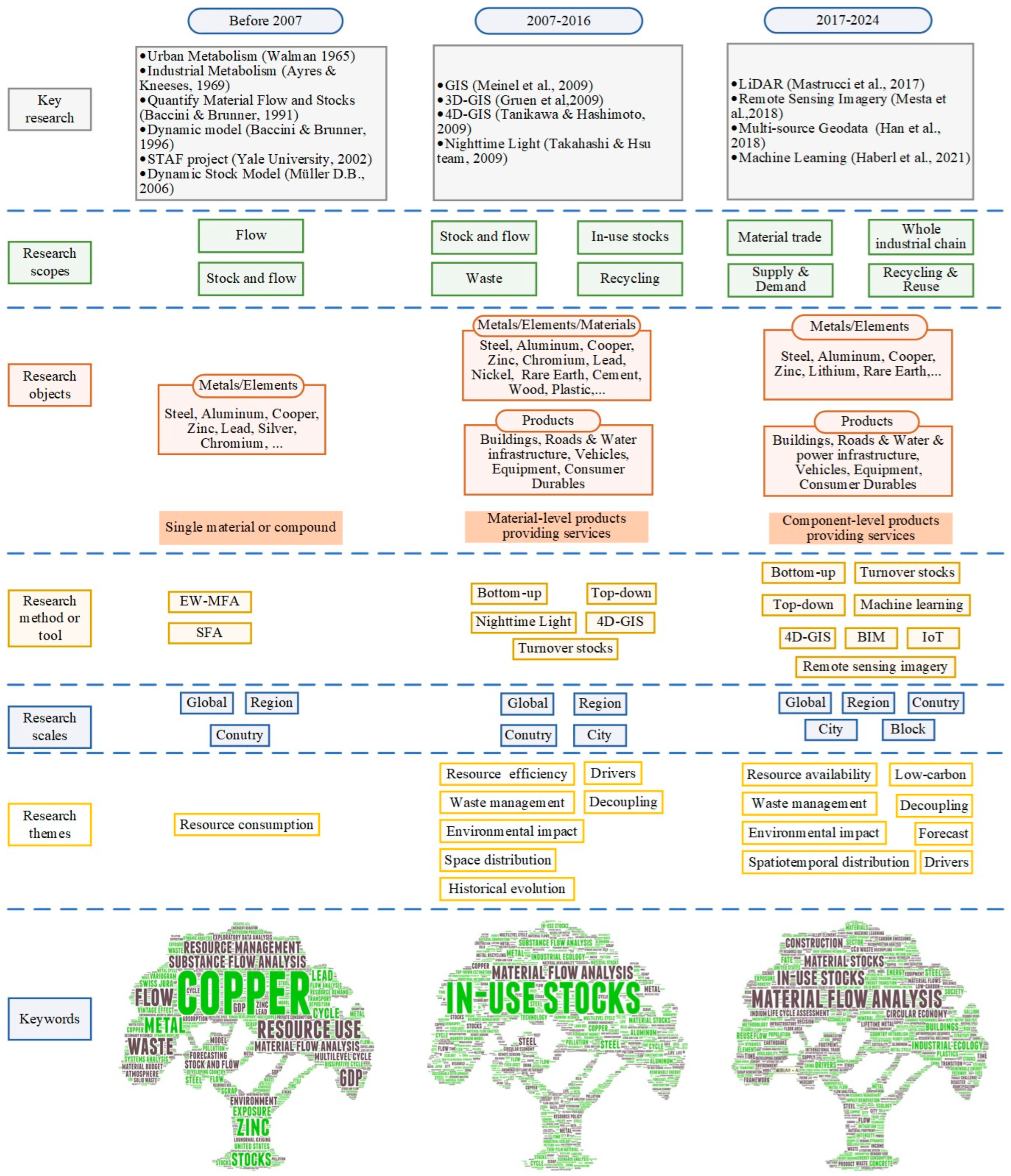A Systems Perspective on Material Stocks Research: From Quantification to Sustainability
Abstract
1. Introduction
2. Materials and Methods
2.1. Methods
2.2. Data
3. Publication Analysis
3.1. Publication Trend
3.2. Source of Publication
3.3. Cooperation Network Analysis
3.4. Historical and Thematic Evolution
4. Key Themes of MS’s Research
4.1. MS’s Quantification
4.1.1. Spatio–Temporal Analysis
4.1.2. Data Refinement
4.1.3. Forecast of Future MS
4.2. MS and Socio–Economic Systems
4.2.1. Drivers of MS
4.2.2. Decoupling and Correlation
4.2.3. Assessment of Socio–Economic Development
4.3. MS and Resources Systems
4.3.1. Waste Management
4.3.2. Resource Availability
4.4. MS and Environment Systems
4.4.1. Environmental Issues
4.4.2. Mitigating Climate Change
4.4.3. The Impact of Environmental Degradation
5. Future Trends in MS Research
5.1. More Refined Spatio–Temporal Analysis
5.2. Building a Comparable Global Data Platform
5.3. Exploration of Evolution Mechanism
5.4. Management of the Whole Industry Chain
5.5. Enhancing Action on Climate Change
5.6. Promoting Research on Two–Way Interaction with Other Systems
6. Conclusions
Supplementary Materials
Author Contributions
Funding
Data Availability Statement
Conflicts of Interest
References
- International Energy Agency. Global Energy and Climate Model; International Energy Agency: Paris, France, 2022. [Google Scholar]
- I.P.R. Resource Efficiency and Climate Change: Material Efficiency Strategies for a Low-Carbon Future; United Nations Environment Programme: Nairobi, Kenya, 2020. [Google Scholar]
- Pauliuk, S.; Heeren, N.; Berrill, P.; Fishman, T.; Nistad, A.; Tu, Q.; Wolfram, P.; Hertwich, E.G. Global Scenarios of Resource and Emission Savings from Material Efficiency in Residential Buildings and Cars. Nat. Commun. 2021, 12, 5097. [Google Scholar] [CrossRef] [PubMed]
- Zhang, X.; Sun, J.; Zhang, X.; Fenglai, W. Statistical Characteristics and Scenario Analysis of Embodied Carbon Emissions of Multi-Story Residential Buildings in China. Sustain. Prod. Consum. 2024, 46, 629–640. [Google Scholar] [CrossRef]
- Regona, M.; Yigitcanlar, T.; Hon, C.; Teo, M. Artificial Intelligence and Sustainable Development Goals: Systematic Literature Review of the Construction Industry. Sustain. Cities Soc. 2024, 108, 105499. [Google Scholar] [CrossRef]
- Dai, T.; Yue, Z. The Evolution and Decoupling of In-Use Stocks in Beijing. Ecol. Econ. 2023, 203, 107606. [Google Scholar] [CrossRef]
- Lanau, M.; Liu, G.; Kral, U.; Wiedenhofer, D.; Keijzer, E.; Yu, C.; Ehlert, C. Taking Stock of Built Environment Stock Studies: Progress and Prospects. Environ. Sci. Technol. 2019, 53, 8499–8515. [Google Scholar] [CrossRef] [PubMed]
- Kloostra, B.; Makarchuk, B.; Saxe, S. Bottom-up Estimation of Material Stocks and Flows in Toronto’s Road Network. J. Ind. Ecol. 2022, 26, 875–890. [Google Scholar] [CrossRef]
- Deng, T.; Fu, C.; Zhang, Y. What Is the Connection of Urban Material Stock and Socioeconomic Factors? A Case Study in Chinese Cities. Resour. Conserv. Recycl. 2022, 185, 106494. [Google Scholar] [CrossRef]
- Liu, Q.; Cao, Z.; Liu, X.; Liu, L.; Dai, T.; Han, J.; Duan, H.; Wang, C.; Wang, H.; Liu, J.; et al. Product and Metal Stocks Accumulation of China’s Megacities: Patterns, Drivers, and Implications. Environ. Sci. Technol. 2019, 53, 4128–4139. [Google Scholar] [CrossRef] [PubMed]
- Pfaff, M.; Glöser-Chahoud, S.; Chrubasik, L.; Walz, R. Resource Efficiency in the German Copper Cycle: Analysis of Stock and Flow Dynamics Resulting from Different Efficiency Measures. Resour. Conserv. Recycl. 2018, 139, 205–218. [Google Scholar] [CrossRef]
- Ren, Z.; Jiang, M.; Chen, D.; Yu, Y.; Li, F.; Xu, M.; Bringezu, S.; Zhu, B. Stocks and Flows of Sand, Gravel, and Crushed Stone in China (1978–2018): Evidence of the Peaking and Structural Transformation of Supply and Demand. Resour. Conserv. Recycl. 2022, 180, 106173. [Google Scholar] [CrossRef]
- Augiseau, V.; Barles, S. Studying Construction Materials Flows and Stock: A Review. Resour. Conserv. Recycl. 2017, 123, 153–164. [Google Scholar] [CrossRef]
- Basuhi, R.; Bhuwalka, K.; Moore, E.A.; Diersen, I.; Malik, R.H.; Young, E.; Billy, R.G.; Stoner, R.; Ceder, G.; Müller, D.B.; et al. Clean energy demand must secure sustainable nickel supply. Joule 2024, 8, 2960–2973. [Google Scholar] [CrossRef]
- Desing, H.; Widmer, R.; Bardi, U.; Beylot, A.; Billy, R.G.; Gasser, M.; Gauch, M.; Monfort, D.; Müller, D.B.; Raugei, M.; et al. Mobilizing Materials to Enable a Fast Energy Transition: A Conceptual Framework. Resour. Conserv. Recycl. 2024, 200, 107314. [Google Scholar] [CrossRef]
- Yue, Z.; Dai, T. Circular Economy Strategies Research for Beijing Buildings in a Low-Carbon Future. Sustain. Cities Soc. 2024, 116, 105894. [Google Scholar] [CrossRef]
- Gerst, M.D.; Graedel, T.E. In-Use Stocks of Metals: Status and Implications. Environ. Sci. Technol. 2008, 42, 7038–7045. [Google Scholar] [CrossRef] [PubMed]
- Müller, E.; Hilty, L.M.; Widmer, R.; Schluep, M.; Faulstich, M. Modeling Metal Stocks and Flows: A Review of Dynamic Material Flow Analysis Methods. Environ. Sci. Technol. 2014, 48, 2102–2113. [Google Scholar] [CrossRef] [PubMed]
- Bao, Y.; Huang, Z.; Guo, Q.; Liu, Y. Spatial Calculation of Urban Built Environment Stock: Progress and Prospects. National Remote Sens. Bulletin 2022, 26, 1909–1919. [Google Scholar] [CrossRef]
- Grossegger, D.; MacAskill, K.; Al-Tabbaa, A. A Critical Review of Road Network Material Stocks and Flows: Current Progress and What We Can Learn from It. Resour. Conserv. Recycl. 2024, 205, 107584. [Google Scholar] [CrossRef]
- Fu, C.; Zhang, Y.; Deng, T.; Daigo, I. The Evolution of Material Stock Research: From Exploring to Rising to Hot Studies. J. Ind. Ecol. 2022, 26, 462–476. [Google Scholar] [CrossRef]
- Yang, D.; Liu, J.; Li, Y.; Jia, Y.; Shi, F. A Review of Urban Building Stock Analysis for the Urban Management. Chinese J. Environ. Manag. 2019, 11, 88–93. [Google Scholar] [CrossRef]
- Nasir, U.; Chang, R.; Omrany, H. Calculation Methods for Construction Material Stocks: A Systematic Review. Appl. Sci. 2021, 11, 6612. [Google Scholar] [CrossRef]
- Chen, C.; Song, M. Visualizing a Field of Research: A Methodology of Systematic Scientometric Reviews. PLoS ONE 2019, 14, 223994. [Google Scholar] [CrossRef] [PubMed]
- Chen, C.; Ibekwe-SanJuan, F.; Hou, J. The Structure and Dynamics of Cocitation Clusters: A Multiple-Perspective Cocitation Analysis. J. Am. Soc. Info. Sci. Technol. 2010, 61, 1386–1409. [Google Scholar] [CrossRef]
- Fischer-Kowalski, M.; Hüttler, W. Society’s Metabolism: The Intellectual History of Materials Flow Analysis, Part I, 1860–1970. J. Ind. Ecol. 1998, 2, 61–78. [Google Scholar] [CrossRef]
- Fischer-Kowalski, M.; Hüttler, W. Society’s Metabolism: The Intellectual History of Materials Flow Analysis, Part II, 1970–1998. J. Ind. Ecol. 1998, 2, 107–136. [Google Scholar] [CrossRef]
- Bain, H.F. The Rise of Scrap Metals. Mineral Economics; Lectures under the Auspices of the Brooking Institution; McGraw-Hill: New York, NY, USA; London, UK, 1932. [Google Scholar]
- Wolman, A. The Metabolism of Cities. Sci. Am. 1965, 213, 178–193. Available online: http://www.jstor.org/stable/24931120 (accessed on 9 July 2025). [CrossRef]
- Ayres, R.U.; Kneese, A.V. Production, Consumption, and Externalities. Am. Econ. Rev. 1969, 59, 282–297. [Google Scholar]
- Baccini, P.; Brunner, P.H. Metabolism of the Anthroposphere; Springer eBooks: Berlin/Heidelberg, Germany, 1991. [Google Scholar]
- Baccini, P.; Brunner, P.H. Regionaler Stoffhaushalt; Spektrum Akademischer Verlag: Berlin/Heidelberg, Germany; Oxford, UK, 1996. [Google Scholar]
- Voet, E.; Heijungs, R.; Mulder, P.; Huele, R.; Kleijn, R.; Oers, L. Substance Flows through the Economy and Environment of a Region Part Ii: Modelling. Environ. Sci. Pollut. Res. 1995, 2, 137–144. [Google Scholar] [CrossRef] [PubMed]
- Voet, E.; Kleijn, R.; Oers, L.; Heijungs, R.; Huele, R.; Mulder, P. Substance Flows through the Economy and Environment of a Region Part i: Systems Definition. Environ. Sci. Pollut. Res. 1995, 2, 90–96. [Google Scholar] [CrossRef] [PubMed]
- Voet, E.; Kleijn, R.; Huele, R.; Ishikawa, M.; Verkuijlen, E. Predicting Future Emissions Based on Characteristics of Stocks. Ecol. Econ. 2002, 41, 223–234. [Google Scholar] [CrossRef]
- Graedel, T.E. The Contemporary European Copper Cycle: Introduction. Ecol. Econ. 2002, 42, 5–7. [Google Scholar] [CrossRef]
- Johnson, J.; Schewel, L.; Graedel, T.E. The Contemporary Anthropogenic Chromium Cycle. Environ. Sci. Technol. 2006, 40, 7060–7069. [Google Scholar] [CrossRef] [PubMed]
- Spatari, S.; Bertram, M.; Fuse, K.; Graedel, T.E.; Shelov, E. The Contemporary European Zinc Cycle: 1-Year Stocks and Flows. Resour. Conserv. Recycl. 2003, 39, 137–160. [Google Scholar] [CrossRef]
- Elshkaki, A.; Voet, E.; Holderbeke, M.; Timmermans, V. The Environmental and Economic Consequences of the Developments of Lead Stocks in the Dutch Economic System. Resour. Conserv. Recycl. 2004, 42, 133–154. [Google Scholar] [CrossRef]
- Müller, D.B. Stock Dynamics for Forecasting Material Flows—Case Study for Housing in the Netherlands. Ecol. Econ. 2006, 59, 142–156. [Google Scholar] [CrossRef]
- Schiller, G. Urban Infrastructure: Challenges for Resource Efficiency in the Building Stock. Build. Res. Inf. 2007, 35, 399–411. [Google Scholar] [CrossRef]
- Oguchi, M.; Kameya, T.; Yagi, S.; Urano, K. Product Flow Analysis of Various Consumer Durables in Japan. Resour. Conserv. Recycl. 2008, 52, 463–480. [Google Scholar] [CrossRef]
- Meinel, G.; Hecht, R.; Herold, H. Analyzing Building Stock Using Topographic Maps and GIS. Build. Res. Inf. 2009, 37, 468–482. [Google Scholar] [CrossRef]
- Gruen, A.; Behnisch, M.; Kohler, N. Perspectives in the Reality-Based Generation, Nd Modelling, and Operation of Buildings and Building Stocks. Build. Res. Inf. 2009, 37, 503–519. [Google Scholar] [CrossRef]
- Tanikawa, H.; Hashimoto, S. Urban Stock over Time: Spatial Material Stock Analysis Using 4d-Gis. Build. Res. Inf. 2009, 37, 483–502. [Google Scholar] [CrossRef]
- Takahashi, K.I.; Terakado, R.; Nakamura, J.; Adachi, Y.; Elvidge, C.D.; Matsuno, Y. In-Use Stock Analysis Using Satellite Nighttime Light Observation Data. Resour. Conserv. Recycl. 2009, 55, 196–200. [Google Scholar] [CrossRef]
- Mastrucci, A.; Marvuglia, A.; Popovici, E.; Leopold, U.; Benetto, E. Geospatial Characterization of Building Material Stocks for the Life Cycle Assessment of End-of-Life Scenarios at the Urban Scale. Resour. Conserv. Recycl. 2017, 123, 54–66. [Google Scholar] [CrossRef]
- Mesta, C.; Kahhat, R.; Santa Cruz, S. Geospatial Characterization of Material Stock in the Residential Sector of a Latin-american City. J. Ind. Ecol. 2018, 23, 280–291. [Google Scholar] [CrossRef]
- Haberl, H.; Wiedenhofer, D.; Schug, F.; Frantz, D.; Virág, D.; Plutzar, C.; Gruhler, K.; Lederer, J.; Schiller, G.; Fishman, T.; et al. High-Resolution Maps of Material Stocks in Buildings and Infrastructures in Austria and Germany. Environ. Sci. Technol. 2021, 55, 3368–3379. [Google Scholar] [CrossRef] [PubMed]
- Han, J.; Chen, W.; Zhang, L.; Liu, G. Uncovering the Spatiotemporal Dynamics of Urban Infrastructure Development: A High Spatial Resolution Material Stock and Flow Analysis. Environ. Sci. Technol. 2018, 52, 12122–12132. [Google Scholar] [CrossRef] [PubMed]
- Mao, R.; Bao, Y.; Huang, Z.; Liu, Q.; Liu, G. High-Resolution Mapping of the Urban Built Environment Stocks in Beijing. Environ. Sci. Technol. 2020, 54, 5345–5355. [Google Scholar] [CrossRef] [PubMed]
- Gao, X.; Nakatani, J.; Zhang, Q.; Huang, B.; Wang, T.; Moriguchi, Y. Dynamic Material Flow and Stock Analysis of Residential Buildings by Integrating Rural–Urban Land Transition: A Case of Shanghai. J. Clean. Prod. 2020, 253, 119941. [Google Scholar] [CrossRef]
- Watari, T.; Yokoi, R. International Inequality in In-Use Metal Stocks: What It Portends for the Future. Resour. Policy 2021, 70, 101968. [Google Scholar] [CrossRef]
- Yuan, L.; Lu, W.; Xue, F.; Li, M. Building Feature-based Machine Learning Regression to Quantify Urban Material Stocks: A Hong Kong Study. J. Ind. Ecol. 2023, 27, 336–349. [Google Scholar] [CrossRef]
- Bao, Y.; Huang, Z.; Mao, R.; Liu, G.; Wang, H.; Yin, G. High-Resolution Mapping of Material Stocks in the Built Environment across 50 Chinese Cities. Resour. Conserv. Recycl. 2023, 199, 107232. [Google Scholar] [CrossRef]
- Schug, F.; Frantz, D.; Wiedenhofer, D.; Haberl, H.; Virág, D.; Linden, S.; Hostert, P. High-resolution Mapping of 33 Years of Material Stock and Population Growth in Germany Using Earth Observation Data. J. Ind. Ecol. 2023, 27, 110–124. [Google Scholar] [CrossRef]
- Liu, Z.; Saito, R.; Guo, J.; Hirai, C.; Haga, C.; Matsui, T.; Shirakawa, H.; Tanikawa, H. Does Deep Learning Enhance the Estimation for Spatially Explicit Built Environment Stocks through Nighttime Light Data Set? Evidence from Japanese Metropolitans. Environ. Sci. Technol. 2023, 57, 3971–3979. [Google Scholar] [CrossRef] [PubMed]
- Yu, B.; Li, L.; Tian, X.; Yu, Q.; Liu, J.; Wang, Q. Material Stock Quantification and Environmental Impact Analysis of Urban Road Systems. Transp. Res. Part D Transp. Environ. 2021, 93, 102756. [Google Scholar] [CrossRef]
- Dai, M.; Jurczyk, J.; Arbabi, H.; Mao, R.; Ward, W.; Mayfield, M.; Liu, G.; Tingley, D.D. Component-Level Residential Building Material Stock Characterization Using Computer Vision Techniques. Environ. Sci. Technol. 2024, 58, 3224–3234. [Google Scholar] [CrossRef] [PubMed]
- Raghu, D.; Bucher, M.J.J.; Wolf, C. Towards a ‘Resource Cadastre’ for a Circular Economy—Urban-Scale Building Material Detection Using Street View Imagery and Computer Vision. Resour. Conserv. Recycl. 2023, 198, 107140. [Google Scholar] [CrossRef]
- Yu, B.; Chen, Q.; Li, N.; Wang, Y.; Li, L.; Cai, M.; Zhang, W.; Gu, T.; Zhu, R.; Zeng, H.; et al. Life Cycle Assessment of Urban Road Networks: Quantifying Carbon Footprints and Forecasting Future Material Stocks. Constr. Build. Mater. 2024, 428, 136280. [Google Scholar] [CrossRef]
- Wang, Z.; Wiedenhofer, D.; Stephan, A.; Perrotti, D.; Bergh, W.; Cao, Z. High-Resolution Mapping of Material Stocks in Belgian Road Infrastructure: Material Efficiency Patterns, Material Recycling Potentials, and Greenhouse Gas Emissions Reduction Opportunities. Environ. Sci. Technol. 2023, 57, 12674–12688. [Google Scholar] [CrossRef] [PubMed]
- Guo, J.; Fishman, T.; Wang, Y.; Miatto, A.; Wuyts, W.; Zheng, L.; Wang, H.; Tanikawa, H. Urban Development and Sustainability Challenges Chronicled by a Century of Construction Material Flows and Stocks in Tiexi, China. J. Ind. Ecol. 2021, 25, 162–175. [Google Scholar] [CrossRef]
- Mao, R.; Bao, Y.; Duan, H.; Liu, G. Global Urban Subway Development, Construction Material Stocks, and Embodied Carbon Emissions. Humanit. Soc. Sci. Commun. 2021, 8, 83. [Google Scholar] [CrossRef]
- Li, S.; Wang, P.; Zhang, Q.; Li, J.; Cao, Z.; Li, W.; Chen, W. Monitoring China’s Solar Power Plant in-Use Stocks and Material Recycling Potentials Using Multi-Source Geographical Data. Resour. Conserv. Recycl. 2025, 212, 107920. [Google Scholar] [CrossRef]
- Liu, Y.; Song, L.; Wang, W.; Jian, X.; Chen, W. Developing a Gis-Based Model to Quantify Spatiotemporal Pattern of Home Appliances and e-Waste Generation—A Case Study in Xiamen, China. Waste Manag. 2022, 137, 150–157. [Google Scholar] [CrossRef] [PubMed]
- Huang, Z.; Bao, Y.; Mao, R.; Wang, H.; Yin, G.; Wan, L.; Qi, H.; Li, Q.; Tang, H.; Liu, Q.; et al. Big Geodata Reveals Spatial Patterns of Built Environment Stocks across and within Cities in China. Engineering 2024, 34, 143–153. [Google Scholar] [CrossRef]
- Heisel, F.; Mcgranahan, J.; Ferdinando, J.; Dogan, T. High-Resolution Combined Building Stock and Building Energy Modeling to Evaluate Whole-Life Carbon Emissions and Saving Potentials at the Building and Urban Scale. Resour. Conserv. Recycl. 2022, 177, 106000. [Google Scholar] [CrossRef]
- Arehart, J.H.; Pomponi, F.; D’Amico, B.; Srubar, W.V. A New Estimate of Building Floor Space in North America. Environ. Sci. Technol. 2021, 55, 5161–5170. [Google Scholar] [CrossRef] [PubMed]
- Yang, D.; Dang, M.; Guo, J.; Sun, L.; Zhang, R.; Han, F.; Shi, F.; Liu, Q.; Tanikawa, H. Spatial–Temporal Dynamics of the Built Environment toward Sustainability: A Material Stock and Flow Analysis in Chinese New and Old Urban Areas. J. Ind. Ecol. 2023, 27, 84–95. [Google Scholar] [CrossRef]
- Shi, F.; Huang, T.; Tanikawa, H.; Han, J.; Hashimoto, S.; Moriguchi, Y. Toward a Low Carbon-Dematerialization Society. J. Ind. Ecol. 2012, 16, 493–505. [Google Scholar] [CrossRef]
- Kleemann, F.; Lederer, J.; Rechberger, H.; Fellner, J. GIS-Based Analysis of Vienna’s Material Stock in Buildings. J. Ind. Ecol. 2017, 21, 368–380. [Google Scholar] [CrossRef]
- Guo, Z.; Hu, D.; Zhang, F.; Huang, G.; Xiao, Q. An Integrated Material Metabolism Model for Stocks of Urban Road System in Beijing, China. Resour. Conserv. Recycl. 2014, 146, 45–54. [Google Scholar] [CrossRef]
- Heeren, N.; Fishman, T. A Database Seed for a Community-Driven Material Intensity Research Platform. Sci. Data 2019, 6, 23. [Google Scholar] [CrossRef] [PubMed]
- Yang, D.; Guo, J.; Sun, L.; Shi, F.; Liu, J.; Tanikawa, H. Urban Buildings Material Intensity in China from 1949 to 2015. Resour. Conserv. Recycl. 2020, 159, 104824. [Google Scholar] [CrossRef]
- Sprecher, B.; Verhagen, T.J.; Sauer, M.L.; Baars, M.; Heintz, J.; Fishman, T. Material Intensity Database for the Dutch Building Stock: Towards Big Data in Material Stock Analysis. J. Ind. Ecol. 2022, 26, 272–280. [Google Scholar] [CrossRef]
- Dai, M.; Ward, W.O.C.; Arbabi, H.; Densley Tingley, D.; Mayfield, M. Scalable Residential Building Geometry Characterisation Using Vehicle-Mounted Camera System. Energies 2022, 15, 6090. [Google Scholar] [CrossRef]
- Hu, S.; Zhang, Y.; Yang, Z.; Yan, D.; Jiang, Y. Challenges and Opportunities for Carbon Neutrality in China’s Building Sector—Modelling and Data. Build. Simul. 2022, 15, 1899–1921. [Google Scholar] [CrossRef]
- Renard, S.; Corbett, B.; Swei, O. Minimizing the Global Warming Impact of Pavement Infrastructure through Reinforcement Learning. Resour. Conserv. Recycl. 2020, 167, 105240. [Google Scholar] [CrossRef]
- Zhang, R.; Guo, J.; Yang, D.; Shirakawa, H.; Shi, F.; Tanikawa, H. What Matters Most to the Material Intensity Coefficient of Buildings? Random Forest-based Evidence from China. J. Ind. Ecol. 2022, 26, 1809–1823. [Google Scholar] [CrossRef]
- Murakami, S.; Oguchi, M.; Tasaki, T.; Daigo, I.; Hashimoto, S. Lifespan of Commodities, Part I. J. Ind. Ecol. 2010, 14, 598–612. [Google Scholar] [CrossRef]
- Oguchi, M.; Murakami, S.; Tasaki, T.; Daigo, I.; Hashimoto, S. Lifespan of Commodities, Part II. J. Ind. Ecol. 2010, 14, 613–626. [Google Scholar] [CrossRef]
- Cao, Z.; Liu, G.; Duan, H.; Xi, F.; Liu, G.; Yang, W. Unravelling the Mystery of Chinese Building Lifetime: A Calibration and Verification Based on Dynamic Material Flow Analysis. Appl. Energy 2019, 238, 442–452. [Google Scholar] [CrossRef]
- Aksözen, M.; Hassler, U.; Kohler, N. Reconstitution of the Dynamics of an Urban Building Stock. Build. Res. Inf. 2017, 45, 239–258. [Google Scholar] [CrossRef]
- Dunant, C.F.; Shah, T.; Drewniok, M.P.; Craglia, M.; Cullen, J.M. A New Method to Estimate the Lifetime of Long-Life Product Categories. J. Ind. Ecol. 2020, 25, 321–332. [Google Scholar] [CrossRef]
- Held, M.; Rosat, N.; Georges, G.; Pengg, H.; Boulouchos, K. Lifespans of Passenger Cars in Europe: Empirical Modelling of Fleet Turnover Dynamics. Eur. Transp. Res. Rev. 2021, 13, 9. [Google Scholar] [CrossRef] [PubMed]
- Zhilyaev, D.; Cimpan, C.; Cao, Z.; Liu, G.; Askegaard, S.; Wenzel, H. The Living, the Dead, and the Obsolete: A Characterization of Lifetime and Stock of Ict Products in Denmark. Resour. Conserv. Recycl. 2021, 164, 105117. [Google Scholar] [CrossRef]
- Schiller, G.; Müller, F.; Ortlepp, R. Mapping the Anthropogenic Stock in Germany: Metabolic Evidence for a Circular Economy. Resour. Conserv. Recycl. 2017, 123, 93–107. [Google Scholar] [CrossRef]
- Wiedenhofer, D.; Fishman, T.; Plank, B.; Miatto, A.; Lauk, C.; Haas, W.; Haberl, H.; Krausmann, F. Prospects for a Saturation of Humanity’s Resource Use? An Analysis of Material Stocks and Flows in Nine World Regions from 1900 to 2035. Glob. Environ. Change 2021, 71, 102410. [Google Scholar] [CrossRef]
- Mcmillan, C.A.; Moore, M.R.; Keoleian, G.A.; Bulkley, J.W. Quantifying U.S. Aluminum in-Use Stocks and Their Relationship with Economic Output. Ecol. Econ. 2010, 69, 2606–2613. [Google Scholar] [CrossRef]
- Cao, Z.; Shen, L.; Zhong, S.; Liu, L.; Kong, H.; Sun, Y. A Probabilistic Dynamic Material Flow Analysis Model for Chinese Urban Housing Stock. J. Ind. Ecol. 2018, 22, 377–391. [Google Scholar] [CrossRef]
- Fishman, T.; Schandl, H.; Tanikawa, H. Stochastic Analysis and Forecasts of the Patterns of Speed, Acceleration, and Levels of Material Stock Accumulation in Society. Environ. Sci. Technol. 2016, 50, 3729–3737. [Google Scholar] [CrossRef] [PubMed]
- Müller, D.B.; Wang, T.; Duval, B. Patterns of Iron Use in Societal Evolution. Environ. Sci. Technol. 2011, 45, 182–188. [Google Scholar] [CrossRef] [PubMed]
- Zhang, L.; Yuan, Z.; Bi, J. Predicting Future Quantities of Obsolete Household Appliances in Nanjing by a Stock-Based Model. Resour. Conserv. Recycl. 2011, 55, 1087–1094. [Google Scholar] [CrossRef]
- Pauliuk, S.; Wang, T.; Müller, D.B. Moving toward the Circular Economy: The Role of Stocks in the Chinese Steel Cycle. Environ. Sci. Technol. 2012, 46, 148–154. [Google Scholar] [CrossRef] [PubMed]
- Song, L.; Ewijk, S.; Masanet, E.; Watari, T.; Meng, F.; Cullen, J.M.; Cao, Z.; Chen, W. China’s Bulk Material Loops Can Be Closed but Deep Decarbonization Requires Demand Reduction. Nat. Clim. Change 2023, 13, 1136–1143. [Google Scholar] [CrossRef]
- Yokoi, R.; Nakatani, J.; Hatayama, H.; Moriguchi, Y. Dynamic Analysis of In-Use Copper Stocks by the Final Product and End-Use Sector in Japan with Implication for Future Demand Forecasts. Resour. Conserv. Recycl. 2022, 180, 106153. [Google Scholar] [CrossRef]
- Wang, L.; Qiu, T.; Zhang, M.; Cao, Q.; Qin, W.; Wang, S.; Wang, L.; Chen, D.; Wild, M. Carbon Emissions and Reduction Performance of Photovoltaic Systems in China. Renew. Sustain. Energy Rev. 2024, 200, 114603. [Google Scholar] [CrossRef]
- Chu, J.; Zhou, Y.; Cai, Y.; Wang, X.; Li, C.; Liu, Q. Flow and Stock Accumulation of Plastics in China: Patterns and Drivers. Sci. Total Environ. 2022, 852, 158513. [Google Scholar] [CrossRef] [PubMed]
- Fishman, T.; Schandl, H.; Tanikawa, H. The Socio-Economic Drivers of Material Stock Accumulation in Japan’s Prefectures. Ecol. Econ. 2015, 113, 76–84. [Google Scholar] [CrossRef]
- Fu, C.; Zhang, Y.; Yu, X. How Has Beijing’s Urban Weight and Composition Changed with Socioeconomic Development? Sci. Total Environ. 2019, 675, 98–109. [Google Scholar] [CrossRef] [PubMed]
- Ding, Y.; Geng, X.; Wang, P.; Chen, W. How Material Stocks Sustain Economic Growth: Evidence from Provincial Steel Use in China. Resour. Conserv. Recycl. 2021, 171, 105635. [Google Scholar] [CrossRef]
- Shen, L.; Yang, Q.; Yan, H. Spatial Characterization Analysis of Residential Material Stock and Its Driving Factors: A Case Study of Xi’an. Buildings 2023, 13, 581. [Google Scholar] [CrossRef]
- Gontia, P.; Thuvander, L.; Wallbaum, H. Spatiotemporal Characteristics of Residential Material Stocks and Flows in Urban, Commuter, and Rural Settlements. J. Clean. Prod. 2020, 251, 119435. [Google Scholar] [CrossRef]
- Lwin, C.M.; Dente, S.M.R.; Wang, T.; Shimizu, T.; Hashimoto, S. Material Stock Disparity and Factors Affecting Stocked Material Use Efficiency of Sewer Pipelines in Japan. Resour. Conserv. Recycl. 2017, 123, 135–142. [Google Scholar] [CrossRef]
- Augiseau, V.; Kim, E. Inflows and Outflows from Material Stocks of Buildings and Networks and Their Space-Differentiated Drivers: The Case Study of the Paris Region. Sustainability 2021, 13, 1376. [Google Scholar] [CrossRef]
- Dombi, M.; Karcagi-Kováts, A.; Tóth-Szita, K.; Kuti, I. The Structure of Socio-Economic Metabolism and Its Drivers on Household Level in Hungary. J. Clean. Prod. 2018, 172, 758–767. [Google Scholar] [CrossRef]
- Klinglmair, M.; Fellner, J. Historical Iron and Steel Recovery in Times of Raw Material Shortage: The Case of Austria during World War i. Ecol. Econ. 2011, 72, 179–187. [Google Scholar] [CrossRef]
- Zhang, C.; Chen, W.; Liu, G.; Zhu, D. Economic Growth and the Evolution of Material Cycles: An Analytical Framework Integrating Material Flow and Stock Indicators. Ecol. Econ. 2017, 140, 265–274. [Google Scholar] [CrossRef]
- Lin, C.; Liu, G.; Müller, D.B. Characterizing the Role of Built Environment Stocks in Human Development and Emission Growth. Resour. Conserv. Recycl. 2017, 123, 67–72. [Google Scholar] [CrossRef]
- Dombi, M.; Harazin, P.; Karcagi-Kováts, A.; Aldebei, F.; Cao, Z. Perspectives on the Material Dynamic Efficiency Transition in Decelerating the Material Stock Accumulation. J. Environ. Manag. 2023, 335, 117568. [Google Scholar] [CrossRef] [PubMed]
- Ding, Y.; Geng, X.; Liu, X.; Zhang, C.; Chen, W. Material Resource Decoupling Dilemma: Convergence and Traps of in-Use Stock Productivity in National Economy Development. J. Environ. Manag. 2024, 351, 119617. [Google Scholar] [CrossRef] [PubMed]
- Yang, X.; Zhang, C.; Li, X.; Cao, Z.; Wang, P.; Wang, H.; Liu, G.; Xia, Z.; Zhu, D.; Chen, W. Multinational Dynamic Steel Cycle Analysis Reveals Sequential Decoupling between Material Use and Economic Growth. Ecol. Econ. 2024, 217, 108092. [Google Scholar] [CrossRef]
- Song, L.; Zhang, C.; Han, J.; Chen, W. In-Use Product and Steel Stocks Sustaining the Urbanization of Xiamen, China. Ecosyst. Health Sustain. 2019, 5, 110–123. [Google Scholar] [CrossRef]
- Liu, Q.; Liu, L.; Liu, X.; Li, S.; Liu, G. Building Stock Dynamics and the Impact of Construction Bubble and Bust on Employment in China. J. Ind. Ecol. 2021, 25, 1631–1643. [Google Scholar] [CrossRef]
- Yang, M.; Liu, N.; Li, Y.; Zhang, Y.; Wang, X.; Zhang, J. Using Material Flow and Stock Indicators to Evaluate Urban Allometry: Evidence from the Beijing–Tianjin–Hebei Region. Ecosyst. Health Sustain. 2023, 9, 84. [Google Scholar] [CrossRef]
- Yang, N.; Gao, J.; Han, F.; Sun, M.; Yang, D.; Shi, F.; Zhang, L. The Material Stock Inequality in Chinese Rural Households. Sustain. Prod. Consum. 2023, 41, 179–186. [Google Scholar] [CrossRef]
- Arora, M.; Raspall, F.; Cheah, L.; Silva, A. Buildings and the Circular Economy: Estimating Urban Mining, Recovery and Reuse Potential of Building Components. Resour. Conserv. Recycl. 2020, 154, 104581. [Google Scholar] [CrossRef]
- Mao, R.; Wu, Y.; Chen, J.; Chen, P.; Li, X. Development Patterns, Material Metabolism, and Greenhouse Gas Emissions of High-Speed Railway in China. Commun. Earth Environ. 2023, 4, 312. [Google Scholar] [CrossRef]
- Soulier, M.; Pfaff, M.; Goldmann, D.; Walz, R.; Geng, Y.; Zhang, L.; Tercero Espinoza, L.A. The Chinese Copper Cycle: Tracing Copper through the Economy with Dynamic Substance Flow and Input-Output Analysis. J. Clean. Prod. 2018, 195, 435–447. [Google Scholar] [CrossRef]
- Wang, T.; Tian, X.; Hashimoto, S.; Tanikawa, H. Concrete Transformation of Buildings in China and Implications for the Steel Cycle. Resour. Conserv. Recycl. 2015, 103, 205–215. [Google Scholar] [CrossRef]
- Islam, M.T.; Huda, N. E-Waste in Australia: Generation Estimation and Untapped Material Recovery and Revenue Potential. J. Clean. Prod. 2019, 237, 117787. [Google Scholar] [CrossRef]
- Habib, K.; Mohammadi, E.; Vihanga Withanage, S. A First Comprehensive Estimate of Electronic Waste in Canada. J. Hazard. Mater. 2023, 448, 130865. [Google Scholar] [CrossRef] [PubMed]
- München, D.D.; Stein, R.T.; Veit, H.M. Rare Earth Elements Recycling Potential Estimate Based on End-of-Life NdFeB Permanent Magnets from Mobile Phones and Hard Disk Drives in Brazil. Minerals 2021, 11, 1190. [Google Scholar] [CrossRef]
- Hu, X.; Yan, X. Estimation of Critical Metal Consumption in Household Electrical and Electronic Equipment in the Uk, 2011–2020. Resour. Conserv. Recycl. 2023, 197, 107084. [Google Scholar] [CrossRef]
- Schuster, V.; Ciacci, L.; Passarini, F. Mining the In-Use Stock of Energy-Transition Materials for Closed-Loop e-Mobility. Resour. Policy 2023, 86, 104155. [Google Scholar] [CrossRef]
- Xun, D.; Hao, H.; Sun, X.; Liu, Z.; Zhao, F. End-of-Life Recycling Rates of Platinum Group Metals in the Automotive Industry: Insight into Regional Disparities. J. Clean. Prod. 2020, 266, 121942. [Google Scholar] [CrossRef]
- Fishman, T.; Myers, R.; Rios, O.; Graedel, T.E.; Oak Ridge National Laboratory Ornl, O.R.T.U. Implications of Emerging Vehicle Technologies on Rare Earth Supply and Demand in the United States. Resources 2018, 7, 9. [Google Scholar] [CrossRef]
- Deetman, S.; Boer, H.S.; Engelenburg, M.; Voet, E.; Vuuren, D.P. Projected Material Requirements for the Global Electricity Infrastructure-Generation, Transmission and Storage. Resour. Conserv. Recycl. 2021, 164, 105200. [Google Scholar] [CrossRef]
- Sun, T.Y.; Bornhöft, N.A.; Hungerbühler, K.; Nowack, B. Dynamic Probabilistic Modeling of Environmental Emissions of Engineered Nanomaterials. Environ. Sci. Technol. 2016, 50, 4701–4711. [Google Scholar] [CrossRef] [PubMed]
- Seck, G.S.; Hache, E.; Bonnet, C.; Simoën, M.; Carcanague, S. Copper at the Crossroads: Assessment of the Interactions between Low-Carbon Energy Transition and Supply Limitations. Resour. Conserv. Recycl. 2020, 163, 105072. [Google Scholar] [CrossRef] [PubMed]
- Schneider, L.; Berger, M.; Finkbeiner, M. Anthropogenic Stock Extended Abiotic Depletion Potential (Aadp) as a New Parameterisation to Model the Depletion of Abiotic Resources. Int. J. Life Cycle Assess. 2011, 16, 929–936. [Google Scholar] [CrossRef]
- United Nations Environment Programme. Global Status Report for Buildings and Construction: Towards a Zero-Emission, Efficient and Resilient Buildings and Construction Sector; United Nations Environment Programme: Nairobi, Kenya, 2022. [Google Scholar]
- Nakamoto, Y.; Nishijima, D.; Kagawa, S. The Role of Vehicle Lifetime Extensions of Countries on Global CO2 Emissions. J. Clean. Prod. 2019, 207, 1040–1046. [Google Scholar] [CrossRef]
- Dien, N.T.; Hirai, Y.; Sakai, S. In-Use Polybrominated Diphenyl Ether (Pbde) Stocks and Atmospheric Emissions in Japan. J. Mater. Cycles Waste Manag. 2017, 19, 1342–1350. [Google Scholar] [CrossRef]
- Li, L.; Liu, O.; Hu, J.; Wania, F. Degradation of Fluorotelomer-Based Polymers Contributes to the Global Occurrence of Fluorotelomer Alcohol and Perfluoroalkyl Carboxylates: A Combined Dynamic Substance Flow and Environmental Fate Modeling Analysis. Environ. Sci. Technol. 2017, 51, 4461–4470. [Google Scholar] [CrossRef] [PubMed]
- Zhong, X.; Hu, M.; Deetman, S.; Steubing, B.; Lin, H.X.; Hernandez, G.A.; Harpprecht, C.; Zhang, C.; Tukker, A.; Behrens, P. Global Greenhouse Gas Emissions from Residential and Commercial Building Materials and Mitigation Strategies to 2060. Nat. Commun. 2021, 12, 6126. [Google Scholar] [CrossRef] [PubMed]
- Li, D.; Shen, L.; Zhong, S.; Elshkaki, A.; Li, X. Spatial and Temporal Evolution Patterns of Material, Energy and Carbon Emission Nexus for Power Generation Infrastructure in China. Resour. Conserv. Recycl. 2023, 190, 106775. [Google Scholar] [CrossRef]
- Istrate, R.; Mas-Fons, A.; Beylot, A.; Northey, S.; Vaidya, K.; Sonnemann, G.; Kleijn, R.; Steubing, B. Decarbonizing Lithium-Ion Battery Primary Raw Materials Supply Chain. Joule 2024, 8, 2992–3016. [Google Scholar] [CrossRef]
- Xin, G.U.; Yihan, C.H.; Lixiao, Z.H.; Yan, H.A. Urban Material Flow in Earthquake and Post-Disaster Reconstruction. J. Beijing Norm. Univ. (Nat. Sci.) 2021, 57, 555–562. [Google Scholar] [CrossRef]
- Tanikawa, H.; Managi, S.; Lwin, C.M. Estimates of Lost Material Stock of Buildings and Roads Due to the Great East Japan Earthquake and Tsunami. J. Ind. Ecol. 2014, 18, 421–431. [Google Scholar] [CrossRef]
- Merschroth, S.; Miatto, A.; Weyand, S.; Tanikawa, H.; Schebek, L. Lost Material Stock in Buildings Due to Sea Level Rise from Global Warming: The Case of Fiji Islands. Sustainability 2020, 12, 834. [Google Scholar] [CrossRef]
- Symmes, R.; Fishman, T.; Telesford, J.N.; Singh, S.J.; Tan, S.Y.; Kroon, K. The Weight of Islands: Leveraging Grenada’s Material Stocks to Adapt to Climate Change. J. Ind. Ecol. 2020, 24, 369–382. [Google Scholar] [CrossRef]
- Arbabi, H.; Lanau, M.; Li, X.; Meyers, G.; Dai, M.; Mayfield, M.; Tingley, D.D. A Scalable Data Collection, Characterization, and Accounting Framework for Urban Material Stocks. J. Ind. Ecol. 2022, 26, 58–71. [Google Scholar] [CrossRef]
- Arora, M.; Raspall, F.; Cheah, L.; Silva, A. Residential Building Material Stocks and Component-Level Circularity: The Case of Singapore. J. Clean. Prod. 2019, 216, 239–248. [Google Scholar] [CrossRef]
- Myers, R.J.; Reck, B.K.; Graedel, T.E. YSTAFDB, a Unified Database of Material Stocks and Flows for Sustainability Science. Sci. Data 2019, 6, 84. [Google Scholar] [CrossRef] [PubMed]
- Song, L.; Han, J.; Li, N.; Huang, Y.; Hao, M.; Dai, M.; Chen, W. China Material Stocks and Flows Account for 1978–2018. Sci. Data 2021, 8, 303. [Google Scholar] [CrossRef] [PubMed]
- Li, X.; Song, L.; Liu, Q.; Ouyang, X.; Mao, T.; Lu, H.; Liu, L.; Liu, X.; Chen, W.; Liu, G. Product, Building, and Infrastructure Material Stocks Dataset for 337 Chinese Cities between 1978 and 2020. Sci. Data 2023, 10, 228. [Google Scholar] [CrossRef] [PubMed]
- Myers, R.J.; Fishman, T.; Reck, B.K.; Graedel, T.E. Unified Materials Information System (UMIS): An Integrated Material Stocks and Flows Data Structure. J. Ind. Ecol. 2019, 23, 222–240. [Google Scholar] [CrossRef]
- Abbiasov, T.; Heine, C.; Sabouri, S.; Salazar-Miranda, A.; Santi, P.; Glaeser, E.; Ratti, C. The 15-Minute City Quantified Using Human Mobility Data. Nat. Hum. Behav. 2024, 8, 445–455. [Google Scholar] [CrossRef] [PubMed]
- Barbieri, L.; D’Autilia, R.; Marrone, P.; Montella, I. Graph Representation of the 15-Minute City: A Comparison between Rome, London, and Paris. Sustainability 2023, 15, 3772. [Google Scholar] [CrossRef]
- Zuo, J.; Zhao, Z. Green Building Research-Current Status and Future Agenda: A Review. Renew. Sustain. Energy Rev. 2014, 30, 271–281. [Google Scholar] [CrossRef]
- Lei, Y.; Xu, X.; Li, J.; Wang, H.; Yue, Q.; Chen, W. Material Flows and Embodied Carbon Emissions of Aluminum Used in China’s Photovoltaic Industry from 2000 to 2020. Resour. Conserv. Recycl. 2024, 215, 108055. [Google Scholar] [CrossRef]
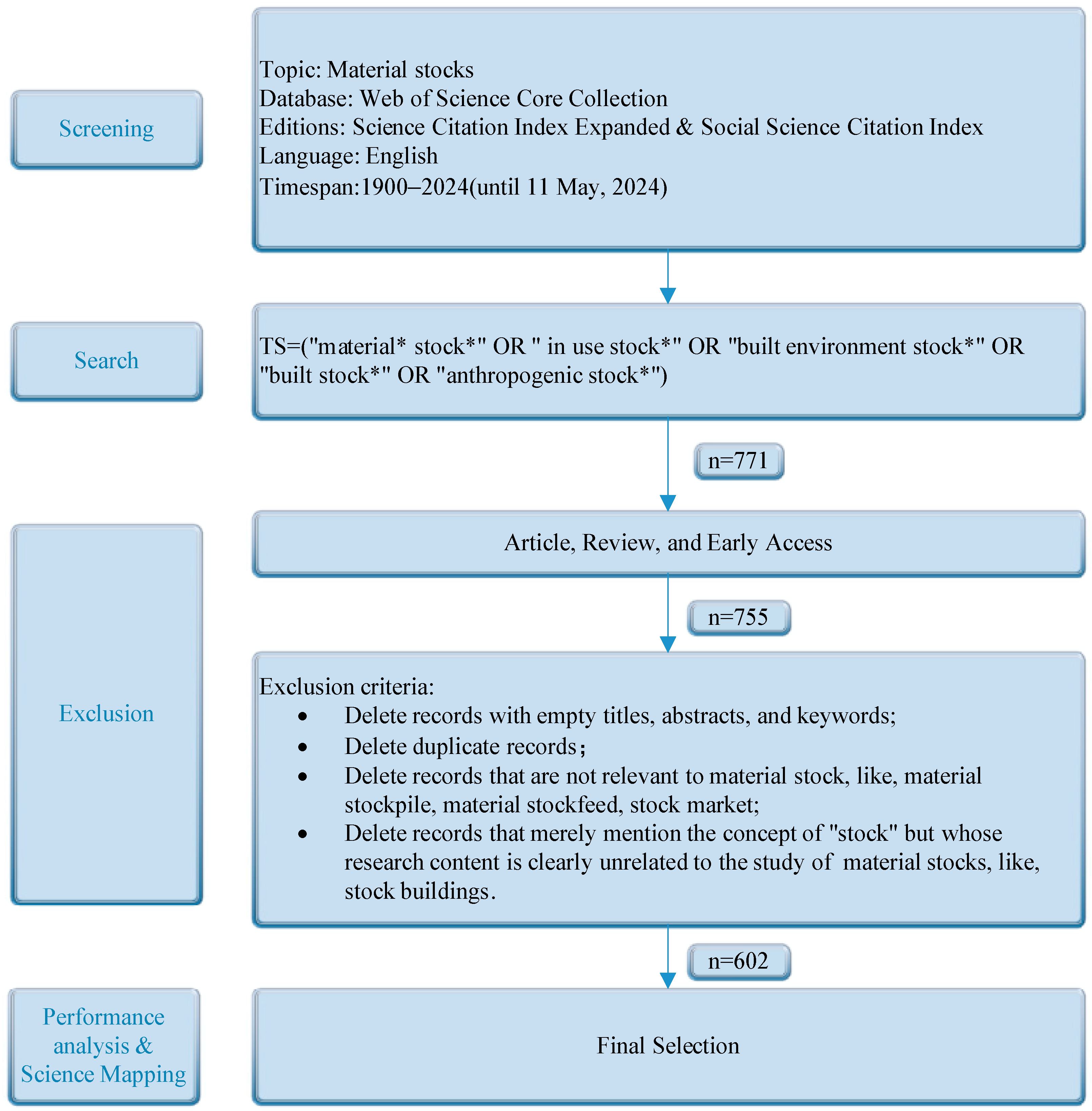
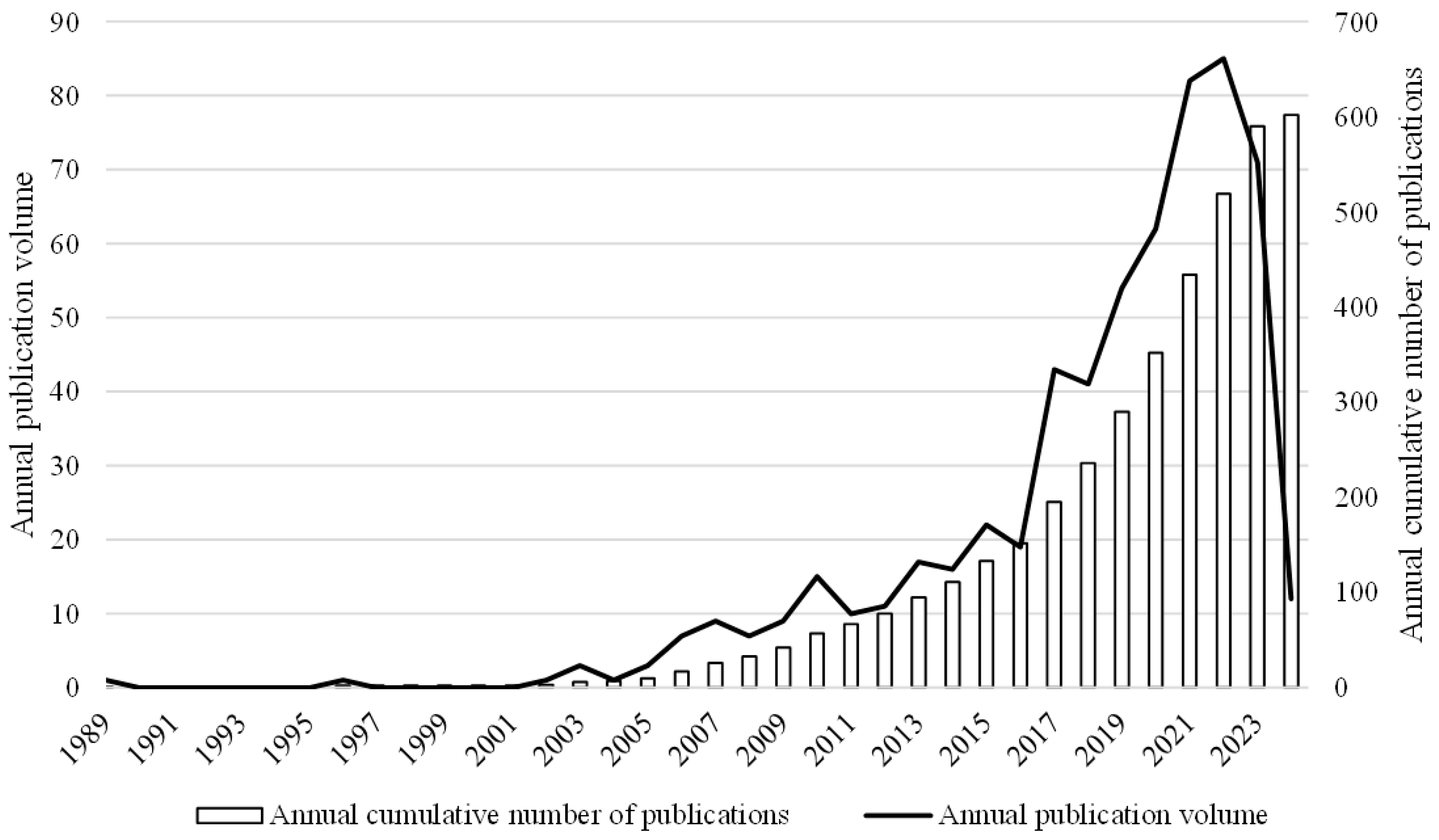
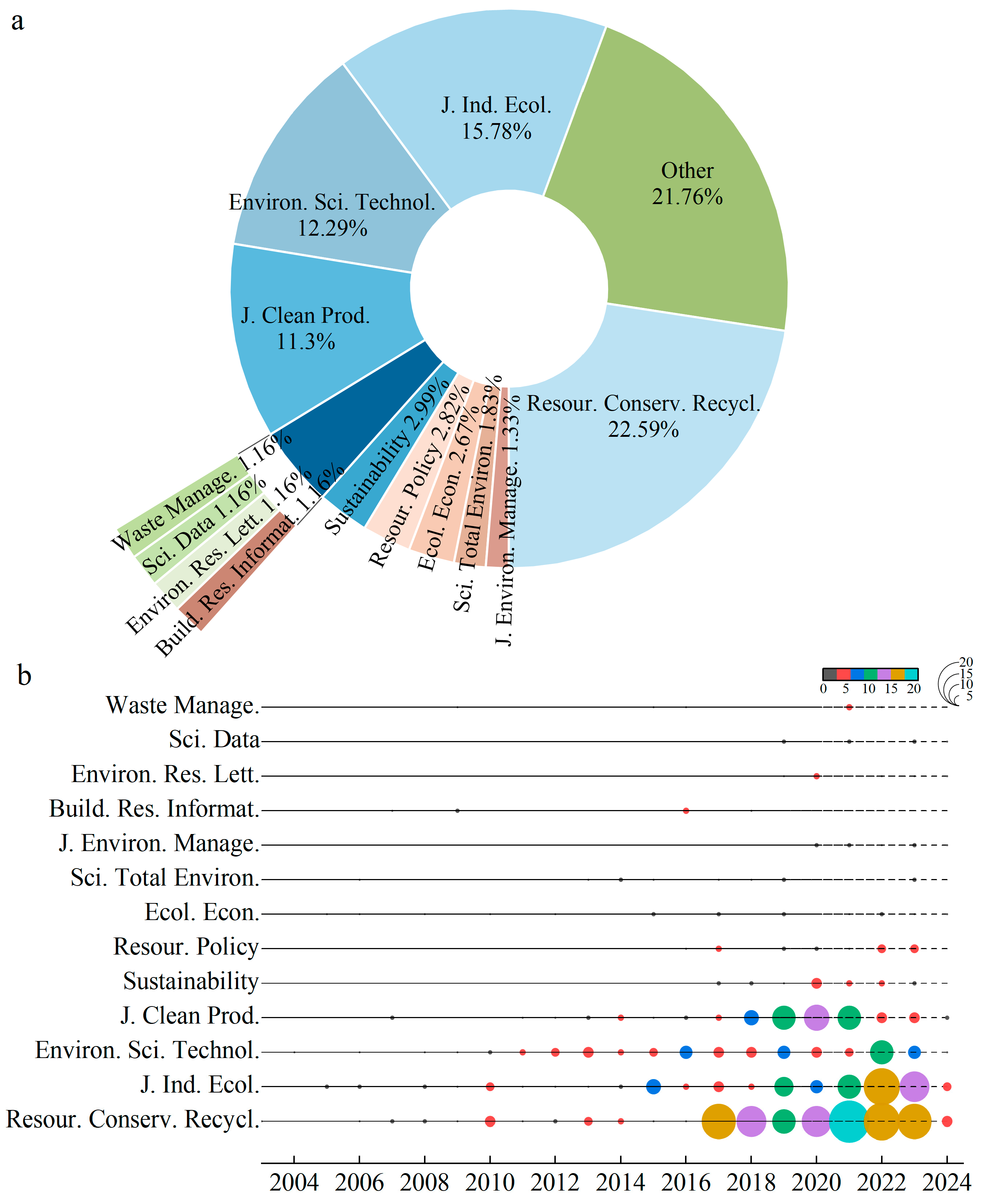
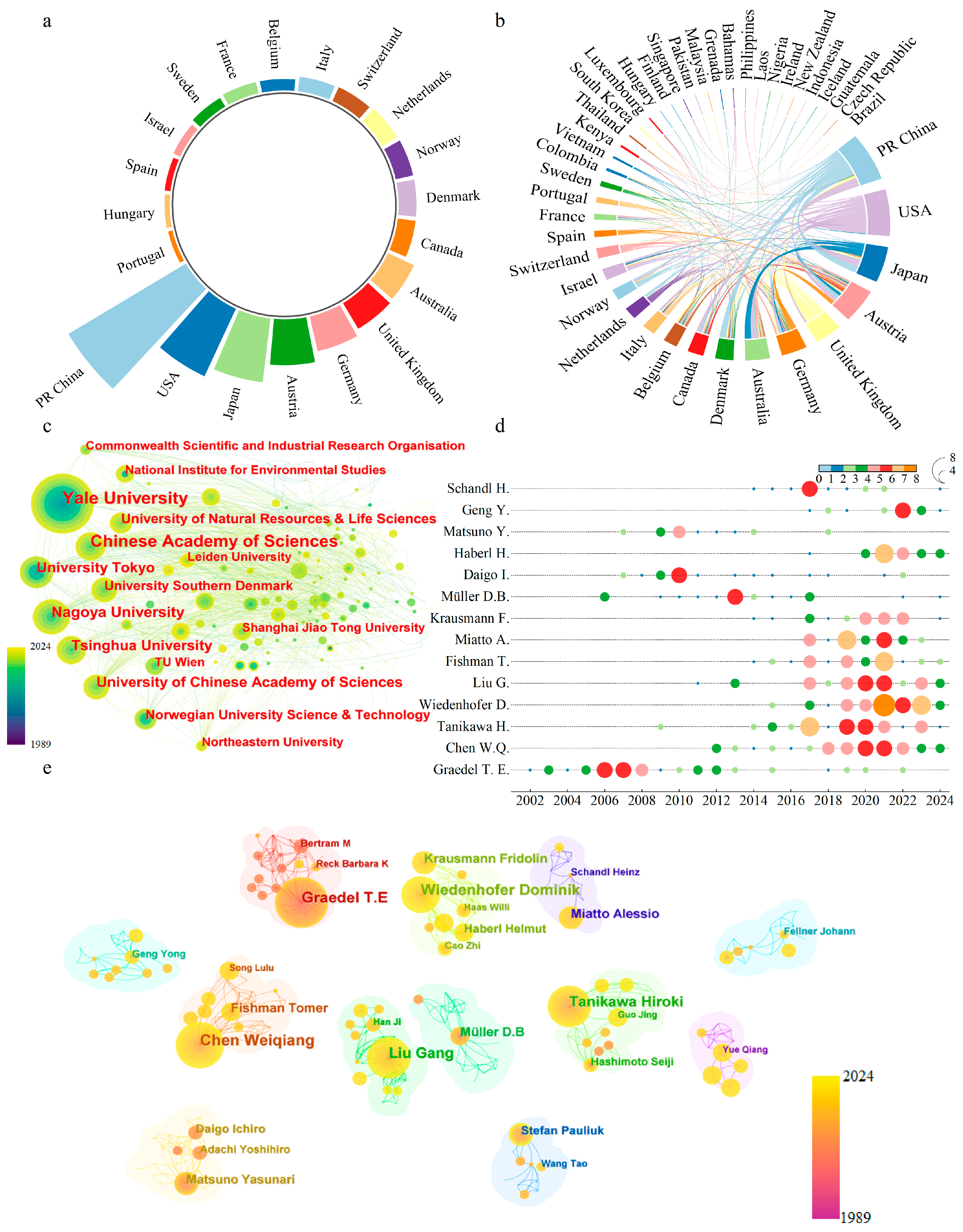
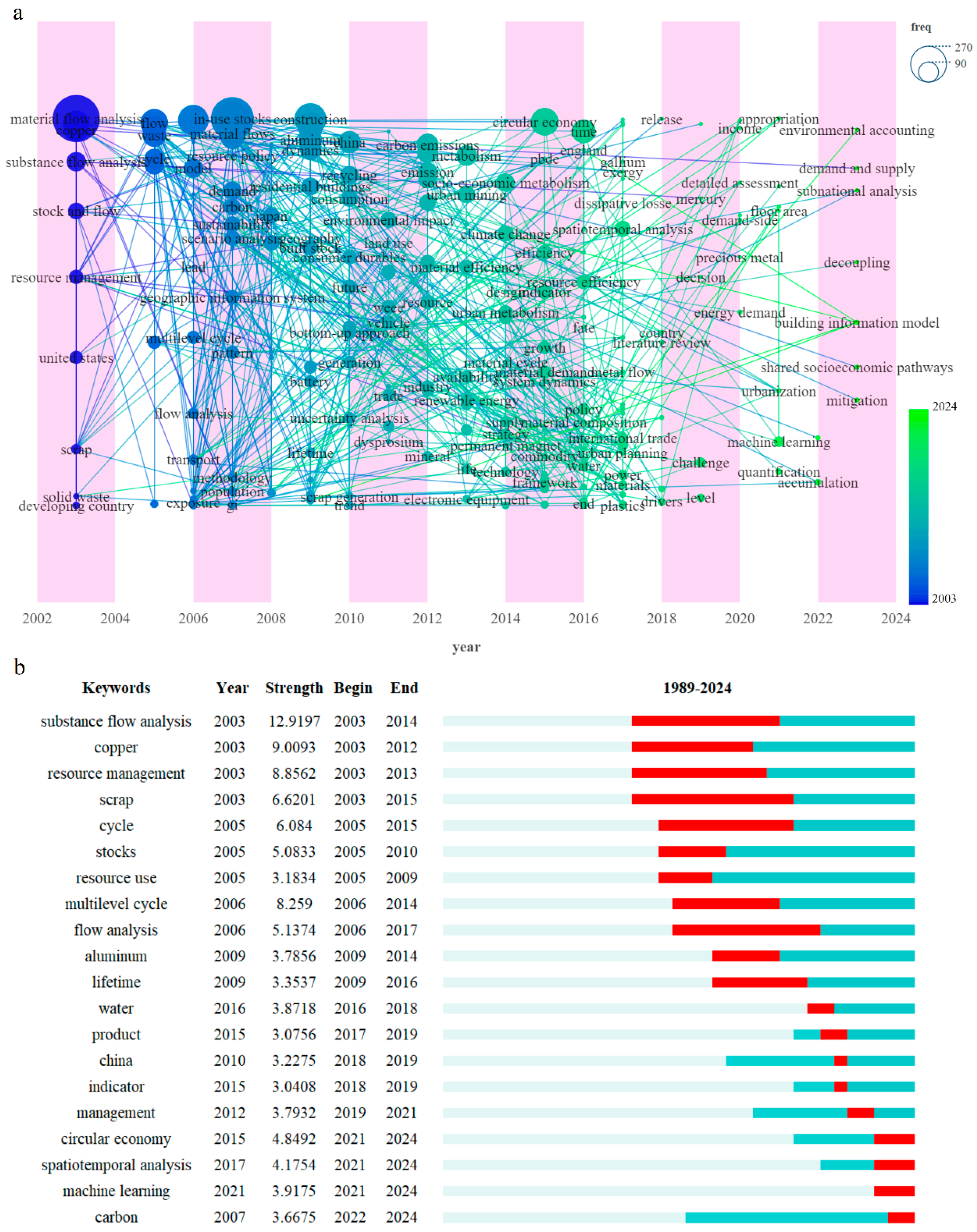

Disclaimer/Publisher’s Note: The statements, opinions and data contained in all publications are solely those of the individual author(s) and contributor(s) and not of MDPI and/or the editor(s). MDPI and/or the editor(s) disclaim responsibility for any injury to people or property resulting from any ideas, methods, instructions or products referred to in the content. |
© 2025 by the authors. Licensee MDPI, Basel, Switzerland. This article is an open access article distributed under the terms and conditions of the Creative Commons Attribution (CC BY) license (https://creativecommons.org/licenses/by/4.0/).
Share and Cite
Dai, T.; Yue, Z.; Zhang, X.; Chi, Y. A Systems Perspective on Material Stocks Research: From Quantification to Sustainability. Systems 2025, 13, 587. https://doi.org/10.3390/systems13070587
Dai T, Yue Z, Zhang X, Chi Y. A Systems Perspective on Material Stocks Research: From Quantification to Sustainability. Systems. 2025; 13(7):587. https://doi.org/10.3390/systems13070587
Chicago/Turabian StyleDai, Tiejun, Zhongchun Yue, Xufeng Zhang, and Yuanying Chi. 2025. "A Systems Perspective on Material Stocks Research: From Quantification to Sustainability" Systems 13, no. 7: 587. https://doi.org/10.3390/systems13070587
APA StyleDai, T., Yue, Z., Zhang, X., & Chi, Y. (2025). A Systems Perspective on Material Stocks Research: From Quantification to Sustainability. Systems, 13(7), 587. https://doi.org/10.3390/systems13070587





